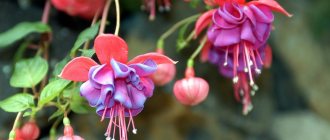Fuchsia flower, photo
- Fuchsia variety Fuchsia Beautiful;
- Fuchsia variety “Little Bell” (Litte Bell);
- Fuchsia variety "Annabel";
- Fuchsia variety “Fuchsia Magellanica” (Fuchsia magellanica);
- Fuchsia variety “Millennium”.
Fuchsia bush varieties, photo
- Fuchsia Lady Thumb;
- Fuchsia Krommenie;
- Fuchsia bush terry;
- Fuchsia Fuchsia Triphylla Flore Coccinea;
- Fuchsia Bella Fuchsia;
Fuchsia ampelous, photo
- Fuchsia ampelous Saskia vander Heijden;
- Fuchsia ampelous Marinka;
- Fuchsia arborescens;
- Fuchsia Trailing Dark Eyes;
- Fuchsia ampelous Royal Mosaic.
What does fuchsia like?
It’s easy to unravel the mystery of fuchsia; just find out what it loves. Let's start with the location. It is best to place such an exotic plant between rays of diffused light. These should not be directly scorching rays that will burn tender leaves. However, fuchsia does not like shade either. This is so destructive for her that she begins to fade.
Fuchsia loves peace, and specifically a permanent “place of residence.” As soon as you start moving her, she will feel it and stop the release of buds. In the worst case scenario, she may become so upset that she will completely throw off the lushly blooming bluebells.
As for temperature exchange, fuchsia loves warmth. The flower is comfortable at temperatures from 8 to 25 degrees. Anything below this level inhibits the development of the plant. The cool season allows the sophisticated beauty to rest and gain new strength before continuous flowering.
Extremely high temperatures are detrimental to the plant. The risk of developing fungal diseases and the infestation of harmful insects increases. In order for the plant to remain in a comfortable location, it is necessary to arrange watering, but we will talk about this below.
What kind of watering does fuchsia like?
Depending on the time of year, fuchsia, like all tropical plants, loves moderate, sufficient watering. This means that in the summer, when the air temperature does not drop below 10 degrees, the bright flower prefers abundant watering and spraying. Bells literally fill with life before our eyes when they get wet. This can also be seen in the condition of the plant. Smooth and juicy buds speak for themselves.
With the onset of the off-season and winter period, watering fuchsia should be significantly reduced. The flowering of the plant stops and it does not require additional attention. It is enough to water it 2 times a week, and stop spraying until summer.
Popular types of fuchsia with photos and names
Having become familiar with the features of caring for fuchsia, it’s time to move on to choosing a variety for your home.
Bushes of small-flowered wild fuchsia species cannot be found in flower shops today. More than 12,000 varieties have been created, and this work continues.
The most important directions of modern breeding: creating plants that are more resistant to low temperatures, with blue, pure yellow or perfectly white flowers.
Initial species for breeding new varieties:
- Bolivian (F.boliviana);
- thin or graceful (F.macrostemma);
- brilliant (F.fulgens);
- sparkling (F. splendens);
- trifoliate (F. triphylla);
- hybrid (F. hybrid).
Old and new varieties are combined into groups. Simple flowering and double, bush and hanging fuchsias are widely represented. Flowers are semi-double, double and densely double. The photo shows an example of a densely double variety.
Description of some varieties:
- Bicentennial. Large double flowers consist of white and orange sepals, a red skirt with orange strokes. After flowering, small berries are formed.
- La Rosita. The bush is compact, with large double flowers that look like pink buds. The skirt is initially lilac, but as it blooms it turns pink.
- Margarita. The bush is dense, the flowers are large, densely double. The sepals and skirt are creamy with a pinkish tint.
- Early flowering variety. The flowers are semi-double, consisting of a bright pink calyx and a black and purple skirt.
- Rohees New Millennium. The bush is strewn with double flowers with red sepals. The skirt is dark cherry.
- A variety with densely double multi-tiered flowers. The sepals are red, bright, the skirt is white with red-pink veins.
- The variety is semi-ampelous. The shoots, which are erect when young, droop over time, so the adult plant looks like an ampel. The flowers are quite large, densely double. The sepals are light with a pink tint, the skirt is lavender in color.
Fuchsia Marinka (Fuchsia Marinka)
An ampelous variety characterized by semi-double flowers. Sepals are bright scarlet. The skirt is red with a subtle purple tint. An unpretentious variety that blooms profusely.
Fuchsia Golden Swingtime
Bush or semi-ampelic variety with huge, densely double flowers. Fuchsia Swingtime, like many other representatives of the species, is two-colored. The plant has red sepals and stamens and a white skirt.
Delicate fuchsia (Piannes Berg)
An ampelous variety with large flowers. The sepals are pink and white, the skirt is terry, white with a cream tint. The petals curl, which gives the flowers an unusual appearance.
Fuchsia Millennium
Ampel and semi-ampel variety, late flowering. The flowers are large, double. The sepals are red, the skirt is blue-violet, almost black. Following the Millennium, a new millennium appeared.
Fans of dark-colored flowers will also like Fuchsia Blackie and the Lady in Black variety.
Bush flower Margarita (Fuchsia Margarita)
The variety is grown as a bush or hanging plant. The flowers are large, densely double, almost round in shape, “waxy” in appearance. Color: white-pink and cream.
Dark Eyes Fuchsia
A variety of indoor plants that is universal in form and care, which can be grown both as a creeping flower and in the form of a beautiful bush using a support. The bright contrasting color of the red sepals and the blue-violet skirt create the image of a festively dressed plant.
Various, bright fuchsias decorate a collection of indoor plants, a cozy terrace and a greenhouse. It is not difficult to grow flowers if you observe the temperature regime, regular watering and timely fertilizing. The main thing is to take the time to acquire knowledge and skills for proper care and reproduction. Fuchsia, like a fairy fairy, will thank its owners and guests with lush blooms.
Planting fuchsia
Fuchsias are grown in two ways: by seed sowing or cuttings. This plant is easy to grow at home. To do this, it is enough to acquire planting material and universal soil. The plant must be planted between hot summer and cold winter. Fuchsia does not like high temperatures and, if grown in unfavorable times, will develop poorly.
It is better to plant fuchsia in a pot with a ventilated bottom, where there are at least 3-4 holes. You need to put drainage at the bottom of the pot. This will allow the plant roots to receive the necessary amount of moisture and not rot.
propagation of fuchsia by seeds
It is necessary to plant fuchsia in seeds as follows: distribute each seed into a plastic cup with loose universal soil. The grain is planted in the ground to a depth of at least 1 cm, watered, placed with the rest of the glasses in a common box and covered with film. The plant will “live” in a kind of mini-greenhouse for 2 months. During this time, it must be watered (as the soil dries) and ventilated. Then it can be transplanted into a large pot.
Pests and diseases
If proper care is provided, problems are rarely encountered. When the slightest signs of disease or insect damage appear, they begin to fight. The main reasons for the withering of a crop can be:
- disruptions in care;
- damage by fungal diseases;
- bug attack.
On a note!
In most cases, all the reasons in combination lead to the fact that the plant begins to wither.
There are two main diseases that can affect fuchsia.
- Root rot. When healthy, the root system is strong and white. As the disease progresses, it becomes brown and soft to the touch. An emergency transplant is performed. The roots are thoroughly washed and the affected areas are removed. The sections are treated with charcoal. The roots are immersed in water until new roots appear. Place in a new pot with nutritious soil.
- Gray rot. The disease affects the green part. The affected areas are cut off. Reduce humidity in the room and provide regular ventilation.
Fuchsia is a very beautiful plant. Many species have been bred for growing at home. Following simple rules of care and planting will help you grow a healthy plant and ensure beautiful, abundant flowering throughout the season.
Propagation of fuchsia at home
Since it is quite problematic to collect fuchsia seeds at home, most gardeners prefer to propagate the plant by cutting off young shoots with 3 or more leaves and germinating them in water. The catch is that fuchsia needs to be pollinated and in order to carry out this biological process, you need to do the pollination yourself.
As for purchased seeds for home propagation, this is a rather problematic matter. When choosing material, you should give preference only to trusted companies, and as we know, fuchsia seeds are traded mainly from abroad and only fortune rules here. Therefore, choose for yourself which method suits you best.
This User Agreement is a public document of the administrator of the site https://sadstroy35.com (hereinafter referred to as the Administrator) and determines the procedure for the use by visitors (hereinafter referred to as the Visitor) of the site https://sadstroy35.com, owned by the Administrator, and the processing, storage and other use of information , received by the Administrator from the Visitor on the Administrator’s website. The site administrator may change this User Agreement at any time without notifying the site visitor.
- A site visitor, leaving any information relating directly or indirectly to a specific or identifiable individual (hereinafter referred to as Personal Data), confirms that he has read this User Agreement and agrees with it.
- With regard to all reported Personal Data, the Visitor gives the Administrator full consent to their processing.
- The site administrator guarantees to the Visitor that the processing and storage of the Visitor’s personal data received will be carried out in accordance with the provisions of the Federal Law of June 27, 2006 No. 152-FZ “On Personal Data”.
- The site visitor understands and agrees that providing the Administrator with any information that has nothing to do with the purposes of the site is prohibited. Such information may be information relating to the state of health, intimate life, nationality, religion, political, philosophical and other beliefs of the Visitor, as well as information that is a commercial, banking and other secret of the Site Visitor.
- The Administrator guarantees to the Visitor that it uses the Personal Data received from the Visitor solely for purposes limited to the marketing, advertising, information purposes of the Administrator, as well as for analysis and research of Site Visitors, as well as for the purpose of providing him with goods and services directly located or not, on the Administrator's website.
- The visitor in accordance with Part 1 of Art. 18 of the Federal Law “On Advertising” gives the Administrator his consent to receive advertising messages via the specified contact information.
- The visitor is solely responsible for violating the law when using the Administrator’s website.
- The Administrator does not bear any responsibility in the event of a violation of the law by the Visitor, and does not guarantee that the content of the site corresponds to the goals of the Site Visitor.
- The site visitor is solely responsible if the rights and legitimate interests of third parties are violated when using the Administrator’s site by the Visitor.
- The Administrator has the right to prohibit the Visitor from using the site if there are legal grounds for doing so.
Propagation of fuchsia by cuttings
As we wrote above, the most preferred method of propagation for fuchsias is cuttings. It is better to choose autumn or spring to grow a new flower. This is done like this: a shoot with 3-4 leaves is cut from a healthy plant. If there are more leaves on a suitable shoot, then remove the excess lower ones and leave the upper ones. We don’t need extra leaves, they will just take away nutrients.
Place the cut branches in a glass of water. The plant will take root faster in soft water. As soon as the first shoots appear, transplant the flower into a pot.
vegetative propagation of fuchsia
Vegetative propagation of fuchsia is ideal for all types of overseas plants. This is especially true for those varieties that you want to reproduce in full image and likeness. In ampelous species, it is considered most suitable to propagate fuchsia by leaf. One leaf is more than enough to cover and grow until transplanted into a larger pot.
Arm yourself with a blade, cut the shoot diagonally where there is at least one leaf. Ideally, it will be a branch with 2-3 leaves and a distance of 3 cm from the lower bud. In this way, a suitable fuchsia variety will grow in the prepared container.
Fuchsia transplant
The plant is replanted if the roots completely fill the pot. Before transplanting an adult fuchsia, pruning is carried out. Healthy shoots are reduced by 30% of their length, and diseased branches are removed. Remove the plant from the pot and check for damaged, rotten roots that need to be trimmed.
What kind of pot is needed for fuchsia
The dishes should not be deep, because the roots of the plant are superficial. Choose relatively wide pots and flowerpots - ceramic or plastic.
The pot should be proportionate to the root system, but with a margin of 2–3 cm. Young plants are planted in containers with a diameter of 12 cm.
Soil mixture
Fuchsia is suitable for neutral or slightly acidic soil (pH from 5.5 to 6.5). The substrate must be well drained. If there is a universal nutrient soil, then add sand, ash or perlite to it.
When planting and replanting, drainage is placed at the bottom of the pot under a layer of substrate - ceramic shards or expanded clay. If you prepare your own soil mixture, you need to take leaf soil, peat and sand in a ratio of 2:1:1/2.
Propagation of fuchsia by cuttings in water with coal
You can grow healthy fuchsia in different ways, but if you choose cuttings, then this secret will clearly come in handy for you. As soon as you have separated the cutting, do not rush to put it in water and leave it on the windowsill. Prepare the environment for favorable plant growth. Add 1 tablet of activated carbon to a glass of water for the cutting.
Just one tablet will purify water from harmful microorganisms and remove hardness from it. In such an environment, the plant will develop much better and you will not notice how you will already see the first shoots of roots. As soon as you see 1-2 cm of newly grown roots, remove the sprout from the water and replant it in prepared soil.
fuchsia propagation video
Reproduction
Fuchsia is planted by seeds or cuttings. During the formation of bushes, shoots remain. They can be used for reproduction. Before rooting, the cuttings are placed in water to form roots.
Then the cuttings are rooted in the prepared soil. To stimulate root formation, young plants are often watered.
When propagated by seeds, they are planted in a nutrient substrate prepared from vermiculite and sand. After several true leaves appear, the seedlings are transplanted into individual pots.
Cuttings
The most common propagation option for this crop is rooting in water. It is best to perform the procedure in the spring. Take a cutting 10-20 cm.
On a note!
Since the shoots harden over time, young cuttings are used. If you take old ones, roots will form, but the process will be slower.
Leaves from the bottom of the cuttings are removed. All large leaves are also trimmed. The cutting is dipped into a container of water and covered with translucent material. In a week the first roots will appear.
The second method of rooting is often used - planting directly in prepared soil, for example, a ready-made peat tablet, perlite, sphagnum. To speed up the rooting process, a greenhouse is organized.
In autumn, plants experience a dormant period when all processes slow down. There is no point in trying to root cuttings during this period. When rooting in hot weather, they provide the plant with coolness and moisture.
Harvesting cuttings in autumn
The best way to store fuchsia in winter is to root young cuttings in early autumn. Several young shoots are cut off from an adult plant. Take 2-3 more cuttings than needed. This is in case the seedlings cannot survive the winter.
Cuttings are cut 15-20 cm long and placed in a container with soil. Can be stored in the refrigerator in plastic bags with sawdust. In the spring, the cuttings are taken out, treated with a weak solution of potassium permanganate and sent into water to form roots.
Propagation by leaves
If it is not possible to use a cutting for rooting, then cut off the leaf. Cut off a large healthy leaf along with its cuttings. It is buried in wet perlite.
Greenhouse conditions are created for the leaf, watered and ventilated regularly. After some time, a rosette of leaves forms at the base. When the young seedling gets stronger, it is separated from the main old leaf and transferred to a separate pot.
Propagation by seeds
Fuchsia is rarely grown at home using seeds. If you really want, you can collect the seeds yourself and use them for planting.
On a note!
The seed method is used by experienced gardeners and breeders.
- Initially, the possibility of pollination by insects or self-pollination is excluded.
- All dust particles are removed from the selected flower (not the blossomed one).
- Pollen of the desired variety is carefully applied to the stigma and stamen.
- The selected bud is wrapped in a piece of gauze or put on a fabric cover.
- The flower is left alone until the fruit ripens completely.
You may be interested in: Favorable days for planting Ageratum for seedlings in 2022 according to the lunar calendar Favorable days for sowing snapdragons for seedlings in 2022 according to the lunar sowing calendar Favorable days for sowing lobelia in 2022 according to the lunar sowing calendar
After the fruit has fully ripened, it is carefully removed with tweezers. Cut in half and collect the seeds. The seeds are dried before storing and planting.
The planting material is distributed over the surface of the soil, and the container is closed with a lid. Place in a bright place without direct sunlight. The room temperature is maintained at 18-22 °C. The artificial greenhouse is regularly ventilated.
Shoots appear in 2-3 weeks. From this moment on, they are ventilated more often. After 2-3 months, the seedlings are ready for picking. Before planting, seedlings are watered abundantly. Transfer to separate containers. Young fuchsias are provided with the necessary conditions. The sprouts are fed every 2 weeks. To ensure that the bush is not too tall, the seedling is pinched.
Pruning fuchsia, how and when
Fuchsia is ampelous and bushy and needs pruning. First of all, this is necessary to renew the plant, and only then for the further growth of new flowers. Unsuitable branches should be removed in late autumn or early spring. It is worth noting that autumn for fuchsia comes when it has already bloomed and is preparing for winter rest. The spring period begins around February, early March.
fuchsia in autumn
Carry out autumn pruning on sprouts that bear fruit with bright bell buds. This is similar to the process of pruning fruit-bearing bushes. Flowering branches cannot be cut, this will damage the plant, but those that were already covered with flowers with decorative skirts are what you need. After winter dormancy, the fuchsia will be ready for new growth and flowering.
pruning fuchsia in spring
Some gardeners postpone pruning until spring. However, this is a personal matter for everyone. When removing unnecessary shoots, attention should be paid to thin stems, damaged ones and those that give the plant additional density. If you want to form a crown of a certain type, then do not hesitate to remove unnecessary shoots. Just do this at a level of 2 cm from the protruding nodules.
video pruning fuchsia in spring
Recommended species and varieties
Among fuchsias, groups of relatively cold-resistant and heat-loving plants can be distinguished.
- Cold-resistant species and varieties
The cold resistance of these fuchsias is only relative. In principle, they can winter in regions with warm winters (on the Black Sea coast) if they grow in well-drained soil and a place sheltered from the winds. Under unfavorable conditions, these fuchsias behave like herbaceous perennials: the aboveground part dies from frost, and in the spring new shoots grow from underground at the base of the bush.
F. magellanica (F. Magellanica)
A bushy plant, the most winter-hardy of the genus. It is characterized by dark crimson sepals, purple petals and prominent stamens. In the most favorable conditions, it can reach a height of 3 m. The flowers are small, about 4 cm long and 2 cm in diameter. The leaves are green, opposite, oblong-oval, pointed, up to 7 cm long. The height and diameter of the plant is 1.2x0.5 m.
bushy plant
Var. gracilis "Aurea"
The bright red sepals and purple petals of this variety look very impressive against the background of narrow golden leaves. The plant has thinner branches than the original species and arched stems.
Var. gracilis "Aurea"
Var. gracilis “Variegata”
The same color is characteristic of the flowers of this variety, but the plant is less tall than the previous one: up to 60 cm in height and up to 60 cm in diameter. Leaves with creamy yellow edges.
Leaves with creamy yellow edges
Var. molinae (syn. “Alba”)
The leaves are light green, white sepals and pastel lilac petals.
Leaves are light green
“Sharpitor” (syn. F. “Overbecks”, F. “Sharpitor”)
The flowers of the cultivar have the same color, which bears gray-green leaves with white edges and reaches 75 cm in height and 60 cm in diameter.
Fuchsia in winter, how to preserve fuchsia in winter
Fuchsias are rather capricious flowers. With the onset of winter, they need a special approach. Watering is reduced several times, and locations where natural light has stopped flowing are additionally illuminated. This can be done using fluorescent lamps.
Fuchsias should not be stored in rooms where the temperature drops below 5-8 degrees, otherwise the plant will stop its growing season and will be completely weakened by spring. Those flowers that were planted and hung in flowerpots are taken out and buried in the ground. They are insulated from above with peat, covered with film and wintered in this form until spring.
How to revive fuchsia after winter, awakening fuchsia after winter
Before the active development of fuchsia begins after winter, it is necessary to transplant the plant into new soil and remove unnecessary shoots. The latter concerns pale and yellowed branches, which develop poorly and give a depressing appearance to such a gorgeous plant.
After winter, fuchsia needs additional feeding. But you should not start fertilizing after transplantation. This should be done after 4 weeks. Try spraying the plant with a solution that stimulates flower growth. For this, use a mixture of water with Zircon or Epin. In order for the plant to smoothly prepare for the growing season, move it to a brighter place.
video fuchsia after winter
Ampel varieties
The uniqueness of this type is that the long branches fall down freely. You can decorate the veranda with these flowers by placing them in flower pots. For volumetric flowering, 2-3 cuttings are planted in one container.
If you graft an ampelous fuchsia onto a bush stamp, you can get a beautiful tree with flowing branches. Canopy varieties prefer partial shade and do not tolerate drafts.
Golden Marinka
Variegated type of ampelous character. Flowering is lush and long. The shoots are of medium length, weakly branched, and hang neatly. The flowers are medium-sized, simple or semi-double. The color is bright scarlet.
An additional decorative effect is created by the yellow tint of green leaves. To make the plant look beautiful, pinch the branches. The stems are strong, but do not become woody. Roots poorly from cuttings. Does not like excess moisture.
First love
The variety is distinguished by strong branching and rapid growth. The flowers are large. The leaves are oval, slightly elongated, green. White cups with a slight pink splash, the skirt is a soft lilac color.
Representatives of this variety are difficult to propagate at home, as cuttings do not take root well.
How to feed fuchsia after winter
Winter for fuchsias ends around February. During this period, you need to treat the leaves of the plant and after 1 month you can start feeding the plant. For the growth of new leaves, it is recommended to use the following solution: 1 teaspoon of magnesium sulfate per 1 bucket of water. Calculate the required dose and brush over the resulting nodules with a watercolor brush.
To stimulate the root system, use Domotsvet, flowering stimulating agents or other fertilizers, which are abundant in garden supermarkets. Before fertilizing, water the plant generously so as not to injure the roots, which have become weaned from the chemicals. If you have just transplanted a perennial, then leave it alone for 3-4 weeks. During this time, create a fertilizer schedule.
Remember that fuchsia, like other plants, requires different feedings that differ according to the growing season. For example, at the beginning of the season it is better to apply fertilizer with a high nitrogen content. With the formation of flower ovaries, you need to switch to products containing potassium and phosphorus. It is best not to skimp and purchase a balanced product. The plant will absorb the missing substances and you will see how it will respond to you with gratitude and begin to form beautiful buds.











